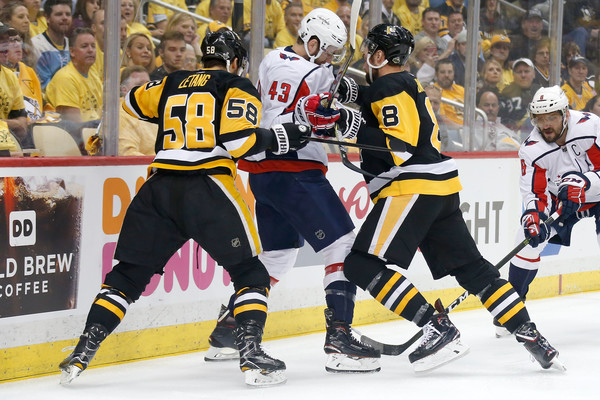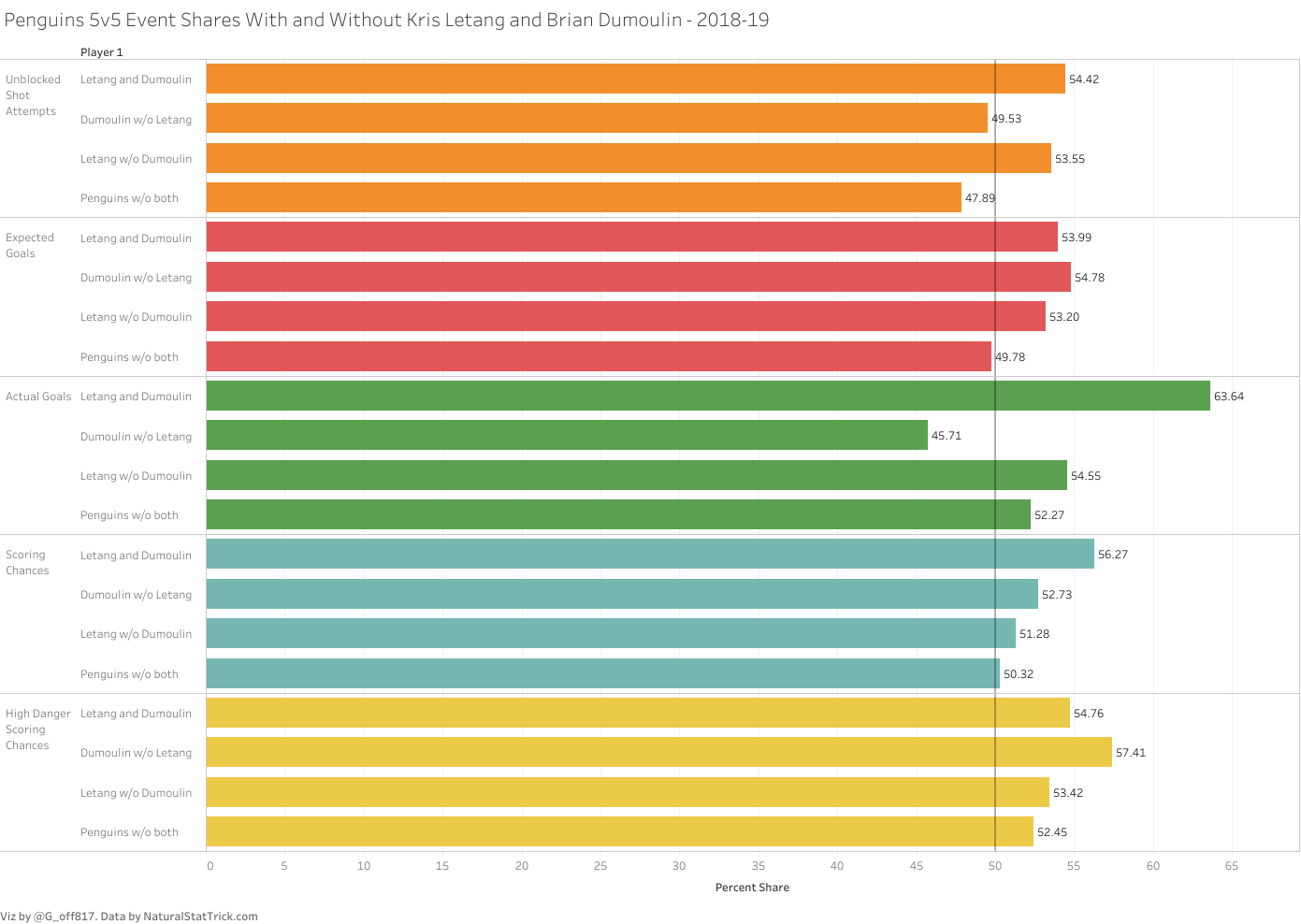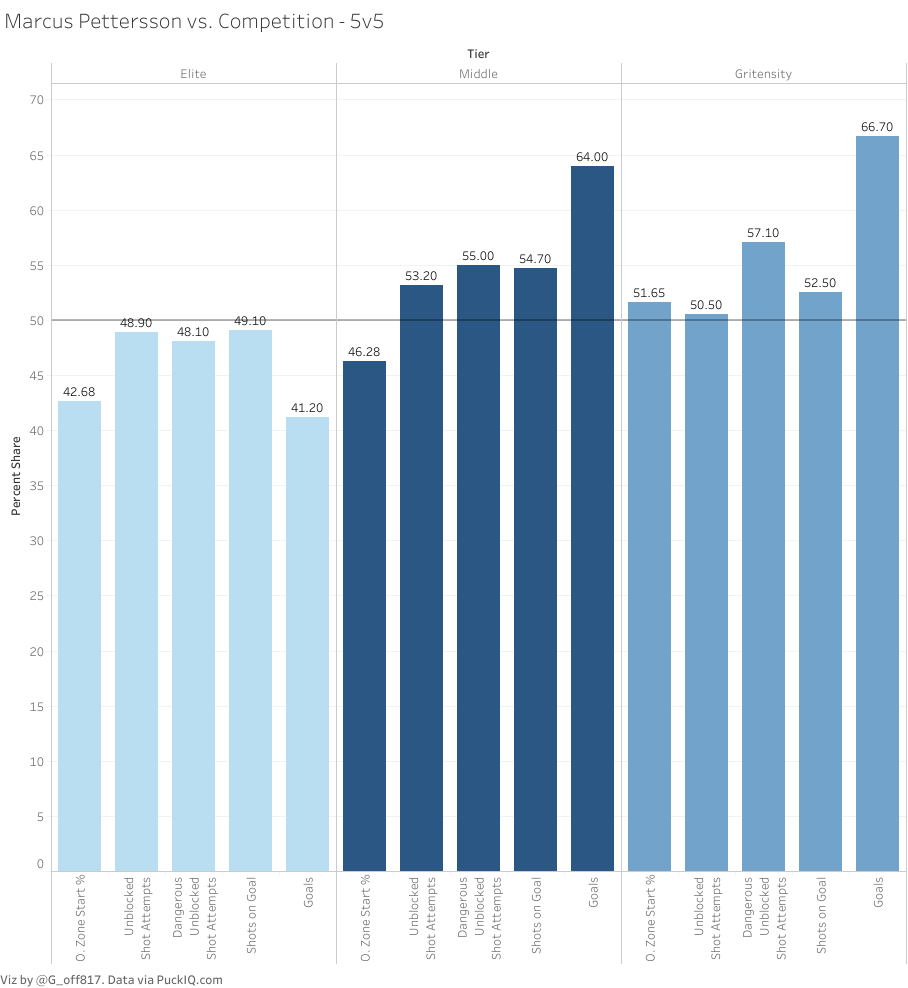
(Source: Kirk Irwin/Getty Images North America)
Barring an extraordinary trade or some exemplary training camp standout performance (looking your way, Juuso), the Penguins blue line is set for the season.
It’s been widely reported that the Penguins will be rolling with Kris Letang, Brian Dumoulin, Justin Schultz, Marcus Pettersson, Erik Gudbranson, and Jack Johnson as their top 6 this season following the offseason move that saw Olli Maatta, arguably the Penguins 4th best defenseman, sent to Chicago for Dominik Kahun.
This, too, without making mention that the Penguins currently sit with negative cap space and Marcus Pettersson without a contract as training camp opens up this Friday, September 13th, without making mention that GMJR likes his D group, and without making mention that the names you see above are the same names that got manhandled and decimated by the Islanders for 4 pathetic games in April.
Rutherford remains adamant that he doesn’t need to make a trade in spite of this, but only he knows how much of that is truly posturing as even he admits that “You can’t make a trade when you can’t find anyone to trade with. Just the way it is.”
Still, it’s hard to see where the money is going to come from without significant salary being shifted out.
Take, for example, the idea that he can place Zach Trotman and Tristan Jarry on waivers for the purpose of sending them to Wilkes-Barre, the latter of whom he would prefer to trade rather than lose for nothing. That would give them just over $500k in cap space with which to work.
Demoting newly re-signed Chad Ruhwedel, a serviceable #6/7/8 defenseman in the league, would give them just over $1.2M with which to work.
Alternatively, waiving Casey DeSmith remains an option, but doing so comes at a cost of him also likely being claimed. Demoting DeSmith instead of Jarry or DeSmith leaving the roster altogether opens up anywhere between $1.6M-1.8M, depending upon the result of the waiver transaction (all salary cap numbers via CapFriendly.com).
Interestingly, that $1.6M figure may work, but would leave the Penguins with next to no cap space heading into the regular season. Via Evolving-Hockey’s contract projection model, Pettersson has a 32.6% chance of signing a 2 year bridge deal with an AAV of just a hair over $1.6M, befitting of the narrative that if the Penguins don’t open up the cap space to sign him long term, they’d have to go the short term route.
In other words, it’s hard to see a scenario where someone isn’t traded to accommodate Marcus Pettersson and that someone should come from the blue line, but it’s anyone’s guess at this point.
Nevertheless, let’s assume that we can trust Jim Rutherford when he says they can sign Pettersson without trading players away and that the Pens top 6-8 D is now what it’s going to be come October 3rd.
What exactly can we expect from those players?
Pair 1 – Corsica Rank: #9 Defense Pairing 1
Brian Dumoulin (#35 LD) – Kris Letang (#4 RD)
Projected Full-Season WAR: 4.8
(ProjFSW data from EvolvingWild and Dom Galamini via Sean Tierney’s WAR Lineup Creator Tool)
Undeniably the undisputed #1 pairing for the Penguins, Letang and Dumoulin are each coming off two of their best seasons in Penguins uniforms.
Letang, in particular, was something else for the Penguins, netting 16 goals and 40 assists across 65 games en route to finishing 6th in Norris voting. The value he brings to the Penguins, whether it be last season or over the course of his career, cannot be understated (read more here).
https://twitter.com/G_Off817/status/1142050783850110982
With Letang, there will always be talk about his “giveaways/turnovers” or his “propensity to make mistakes,” but the simple fact is this: the Penguins are flat out better with Letang on the ice. Period.
And with Brian Dumoulin, both Letang and the Penguins are even better. First, let’s look at the shares of events that the Penguins control at 5v5 with both, with one or the other, and without both:
To some varying degrees, you can make the case that Dumoulin makes Letang even better and Letang elevates Dumoulin as well. But, more importantly, across the board it becomes clear that the Penguins control the 5v5 events that take place when Letang and Dumoulin are on the ice than when they are not.
We can see this effect, too, when looking at the rate of 5v5 unblocked shot attempts by location to see just what the Penguins have from their top pairing, relative to that of the league average, via HockeyViz.com.

Without those two on the ice, the Penguins are marginally below average offensively (-2% Threat), but marginally above average defensively (-2% Threat).
Given what we’ve seen above with the Penguins 5v5 shares with and without Letang over the course of his career, the Penguins “being average” without Letang on the ice last season checks out.
Pair 2 – Corsica Rank: #10 DP2
mARCUS PETTERSSON (#50 LD) – JUSTIN SCHULTZ (#23 RD)
Projected Full-Season WAR: 1.3
This is where things get interesting, irrespective of Pettersson’s contract situation.
Depending upon who you ask, there’s a degree of uncertainty about whether or not Pettersson is a top 4 defenseman quite yet. On this team, given the basic existence of Jack Johnson and Erik Gudbranson, the case can be made that Pettersson is exactly that right now. Considering Corsica’s ranking of him as the #50 LD and 62 being the cutoff for a top 2 pairing LD, the case gets stronger.
To that end, only one Penguin defenseman saw a lower percentage of offensive zone starts at 5v5 than Pettersson’s 43.10% (Erik Gudbranson at 40%). Via PuckIQ.com, who breaks down player performance against Elite, Middle, and “Gritensity” competition, we can see how Pettersson shook out with the Penguins against the varying tiers of competition:
A few things stand out here, notably that Pettersson was fantastic against competition that wasn’t classified as Elite (though wasn’t terribly bad against Elite competition either). In other words, Pettersson is more than capable of holding his own against the players he’d be play against night in and night out in a second pairing role.
Which brings us to Justin Schultz, whose 2018-19 season can only be classified as “bad.” The easy thing is to point to Jack Johnson as the reason, but the truth is that Justin Schultz was still a sub-50% player in terms of unblocked shot attempts and expected goals even when he was away from Jack Johnson (though, admittedly the sample size away from Johnson was just 107:13 of 5v5 play):
https://twitter.com/G_Off817/status/1166771013910257665
The fact remains that Johnson-Schultz simply did not work last season, presumably because neither are particularly adept defenders (and Schultz was coming back from a leg break), which would certainly explain why no Penguin defender that has played at least 300 5v5 minutes over the last 3 seasons has seen a higher percentage of offensive zone starts than Justin Schultz at 56.58% (Johnson clocks in at 2nd at 54.24%).
What’s also true is that there aren’t enough shelter-able minutes to go around and if the goal is to shelter the 3rd pairing, the training wheels will have to come off of the second pairing. And for a guy like Schultz, his greatest success in his Penguins career has come when playing with a guy that is a solid skater, can move the puck up ice, and can handle himself defensively in Ian Cole.
You’d be hard-pressed to find anyone that doesn’t think that Marcus Pettersson is an upgrade in each of those categories over Cole, especially considering that it would give the Penguins two puck-movers on either side of the ice to prevent teams from shadowing Schultz and forcing someone like Johnson to break the puck out (more on that below).
And given Pettersson’s success against the quality of competition these two would face on a nightly basis, a Pettersson-Schultz pairing seems to make unlimited sense this season.
Pair 3 – Corsica Rank: #27 DP3
jACK JOHNSON (#121 LD) – ERIK GUDBRANSON (#81 RD)
Projected Full-Season WAR: -1.1
What’s there to say about Jack Johnson that hasn’t already been said? From chasing hits to dragging down his teammates to generally being unable to keep up with the pace of the NHL, he was exactly as he’s been his entire career. That is: pretty damn lousy.
https://twitter.com/G_Off817/status/1166773197615837184
Gudbranson, on the other hand, was better than advertised for the Penguins after GMJR acquired him at the deadline for Tanner Pearson. His career to that point had been sub-optimal, but a resurgence alongside Marcus Pettersson. How much of that was due to playing 19 games with Pettersson, with whom he played 269:10 of his 317:31 of 5v5 time, or due to the “new team adrenaline rush” remains to be seen.
But when you look at Gudbranson’s last 317:31 minutes of 5v5 play in comparison to that of his last 2520:28, it stands to reason that his 19 games with the Penguins were a bit of an outlier:
| Erik Gudbranson – 5v5 | Last 3 Seasons | With PIT |
| TOI | 2520:28 | 317.31 |
| Off. Zone Start % | 46.25% | 40.00% |
| Unblocked Shot Attempt For Share | 45.32% | 54.01% |
| Relative Unblocked Shot Attempt Share | -5.09 | 3.15 |
| Goals For Share | 38.07% | 52.94% |
| Relative Goals For Share | -13.73 | -5.39 |
| Expected Goals For Share | 45.07% | 59.12% |
| Relative Expected Goals For Share | -4.60 | 6.26 |
| Scoring Chances For Share | 43.46% | 58.43% |
| Relative Scoring Chances For Share | -5.21 | 5.76 |
| High Danger Scoring Chances For Share | 45.29% | 64.86% |
| Relative High Danger Scoring Chances For Share | -3.99 | 8.78 |
When you have such huge swings like this, whether it be in the overall percent shares or in the relative data, like we see above, it should raise a number of red flags.
None of this is meant to downplay the fact that the Penguins were quite good with Gudbranson on the ice in those 19 games, both overall and relative to the rest of the team. But, given the history of the player, the reason why he was able to buck every trend he had previous established is uncertain (unless you buy into Pettersson being that good).
But one thing is for certain: Gudbranson was exposed against the Islanders in the playoffs.
Take the clip below for example. You’ll see Pettersson go back for a puck while Tom Kuhnhackl and the rest of the Islanders forecheck target Pettersson and only Pettersson, a strategy they employed against Justin Schultz as well.
Here, the sequence ends with Bailey swooping in and feeding Nelson in front as both Pettersson and Gudbranson chase Bailey. The larger issue, though, is that the Islanders wanted Gudbranson (and Johnson) to be the outlet guys for Pettersson (and Schultz), knowing that Gudbranson and Johnson aren’t quality players at moving the puck.
https://twitter.com/G_Off817/status/1118307288635379712
Brock Nelson is the key to this approach. Watch where he comes from again- it’s from the point, where he’s in a position to seal off the wall from Gudbranson, should he have been afforded the opportunity to pass the puck out. Best case scenario, Gudbranson goes high off the glass and hopes a Penguins forward can latch onto it. Worst case, it ends up in the back of the net.
Therein lies the problem with a potential Johnson-Gudbranson pairing. Neither are known to be proficient skaters or puck movers and, as we saw with Johnson, giving them a ton of offensive zone starts or delicate deployments may not make a difference in keeping one (or both) of them from being liabilities.
EXTRAS
JUSSO RIIKOLA, CHAD RUHWEDEL
Projected Full-Season WAR
Riikola – Gudbranson: 0.1
Riikola – Ruhwedel: 0.2
Johnson – Ruhwedel: -1.0
Excluding Zach Trotman from this conversation, the Penguins are left with two other defensemen that can/will likely see time this season.
We know the story already with Ruhwedel. He’s not going to wow you or be anything more than a reasonably decent depth defender that won’t sink your team from a possession standpoint. He’s comfortable with the puck on his stick, possesses skating ability, and generally doesn’t spend a lot of time stuck in his own end of the ice. He’s your perfect 6/7/8 d-man.
Riikola, on the other hand, is a bit of a wild card.
Riikola came into last season as a 24 year old rookie making the jump from Finland to North America. There were some growing pains, but a few things were evident about his game: he can skate, he has a bomb of a shot, and plays with some physicality.
In total, he got 37 games with the big club and showed flashes of brilliance prior to Pettersson’s arrival from Anaheim, getting 559:57 of 5v5 ice time across those games playing almost exclusively with Olli Maatta, scoring 2 goals (both on the powerplay) and 3 assists.
To that end, his numbers were pretty underwhelming. He found himself owning a sub-50% share of on-ice of unblocked shot attempts (46%), shots on goal (45.66%), expected goals (47.10%), and scoring chances (49.06%), despite controlling 53.85% of the goals scored and 51.30% share of the high danger scoring chances at 5-on-5.
Though those numbers are less than ideal, they aren’t worse than what the Penguins may employ as the current #3 LD, where Riikola owns a sizable edge in his overall hockey playing ability, even if the data is underwhelming:
https://twitter.com/G_Off817/status/1092969470048358405
After a full season of adjusting to the North American game, Riikola could find himself contending for that spot on the 3rd pairing for the Penguins come opening night and the likelihood of them being better off for it is high.
All in all, the Penguins defense isn’t in the worst shape it’s ever been in.
Under its current construction, they have an elite first pair, a very good second pair (if it’s Pettersson and Schultz), and an anchor so large as a 3rd pair that it has its own moons.
Over the course of an 82 game season, you can probably hide that shortcoming, assuming injuries don’t derail your plans (they will). You may even be able to hide it in the playoffs for a short time, but as the postseason draws on and the better teams stay in it, a 3rd pairing like the Penguins currently have will be exposed. Don’t believe it? Look only as far as the 2017 Cup run and how the Penguins ripped the Preds 3rd pairing of Yannick Weber and Matt Irwin apart.
All this is to say that the Penguins should be fine to make the postseason for the 14th straight year, but the (lack of) depth on D may be their undoing, particularly if it results in a net negative impact on the forward depth.
Add The Sports Daily to your Google News Feed!



